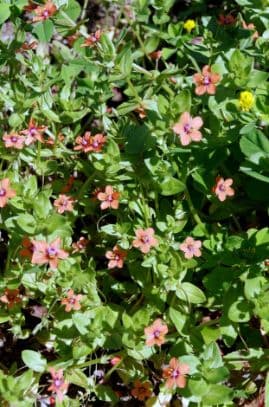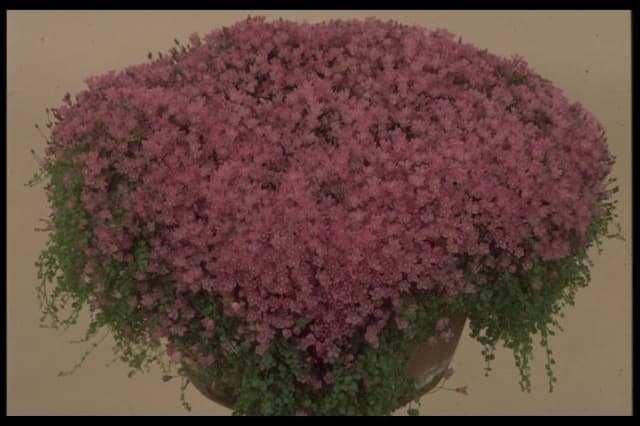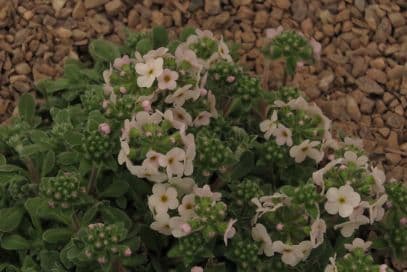Allioni's primrose Primula allionii 'New Dawn' (Au)

ABOUT
The 'New Dawn' is a captivating variety of baby primrose known for its charming blooms. It features a lavish array of flowers that are distinguished by their soft hue, which exudes an ethereal, pastel tone. The petals have a delicate, rounded shape that comes together in a compact cluster, presenting a visual appeal that is both tidy and abundant. Hugging the flowers, the foliage forms a lush backdrop. The leaves are typically deep green with a slightly textured surface that adds depth and interest to the overall aesthetic. The striking contrast between the vibrant leaves and the lighter flowers creates a captivating display that is a feast for the eyes. The 'New Dawn' is often appreciated for its ability to enrich the landscape with its subtle yet striking beauty, offering a sense of tranquility and gentle color to gardens and decorative pots.
About this plant
 Names
NamesFamily
Primulaceae
Synonyms
Allioni's Primrose, New Dawn Primula
Common names
Primula allionii 'New Dawn' (Au)
 Toxicity
ToxicityTo humans
Primula allionii 'New Dawn' is commonly known as Allioni's primrose. There is limited specific information available on the toxicity of this exact cultivar to humans. In general, Primula species can cause mild irritation if ingested, and some people might experience dermatitis from handling them due to the presence of primin, a skin irritant. Reactions can include gastrointestinal distress, such as nausea, vomiting, or diarrhea if ingested. If skin contact occurs, it might cause redness, itching, or a rash. As with any plant, it is advisable to keep them out of reach of children and to wash your hands after handling.
To pets
Allioni's primrose has not been specifically identified as toxic to pets. However, similar precautions as for humans apply since general Primula species can potentially cause mild gastrointestinal upset if ingested by pets, such as cats or dogs. Symptoms can include vomiting and diarrhea. It is wise to prevent pets from ingesting this plant, and if accidental ingestion occurs, monitor for any signs of illness and consult a veterinarian.
 Characteristics
CharacteristicsLife cycle
Perennials
Foliage type
Evergreen
Color of leaves
Green
Flower color
Pink
Height
6 inches (15 cm)
Spread
6 inches (15 cm)
Plant type
Herb
Hardiness zones
5
Native area
Europe
Benefits
 General Benefits
General Benefits- Aesthetic Appeal: Primula allionii 'New Dawn' adds vibrant color to gardens with its striking flowers, enhancing visual interest.
- Compact Growth: Its small size makes it suitable for rock gardens and containers where space is limited.
- Early Spring Bloomer: As one of the first flowers to bloom in spring, it brings life to the garden after winter.
- Attracts Pollinators: The flowers attract bees and butterflies, promoting biodiversity.
- Low Maintenance: It is relatively easy to care for, requiring minimal upkeep once established.
- Tolerance to Cold: This Primula is hardy to a variety of climates, tolerating cold temperatures well.
- Versatility in Garden Design: 'New Dawn' can be used in a variety of garden designs, including alpine and rock gardens.
 Medical Properties
Medical PropertiesThis plant is not used for medical purposes.
 Air-purifying Qualities
Air-purifying QualitiesThis plant is not specifically known for air purifying qualities.
 Other Uses
Other Uses- As a natural dye: The flowers of the Primula can be used to extract natural dyes for coloring fabrics or crafts in shades of yellow, red, or pink, depending on the mordant used.
- Artistic inspiration: Artists may use the vibrant colors and unique form of Primula as subjects in watercolor paintings, drawings, or photography projects.
- Educational tool: Primula can be used in botany classes to teach students about plant morphology and the diversity of the plant kingdom.
- Floral arrangements: With its compact size and attractive flowers, Primula makes an excellent addition to small, delicate floral arrangements for events and home decor.
- Crafting pressed flowers: The blooms of Primula can be pressed and preserved to be used in making bookmarks, greeting cards, or other decorative crafts.
- Fairy gardens: Primula's petite size and colorful flowers make it an enchanting addition to whimsical fairy gardens or miniature landscapes.
- Gift plants: Due to its charming appearance, Primula can be potted and given as a living gift for occasions such as Mother's Day or housewarmings.
- Perfumery: Although not commonly used, the subtle scent of Primula flowers might be captured to create unique perfumes or scented sachets.
- Photographic projects: Primula can be included in macro photography projects to capture the intricate beauty of its blooms and foliage.
- Seasonal decorations: Fresh or dried Primula flowers can be incorporated into seasonal wreaths or centerpieces to add a splash of color to holiday decor.
Interesting Facts
 Feng Shui
Feng ShuiThe Primrose is not used in Feng Shui practice.
 Zodiac Sign Compitability
Zodiac Sign CompitabilityThe Primrose is not used in astrology practice.
 Plant Symbolism
Plant Symbolism- Hope and renewal: The common name 'New Dawn' suggests the beginning of a new day or era, symbolizing fresh starts and the renewal of life.
- Youth and vitality: Primulas, in general, are often associated with youthfulness and vitality due to their bright and varied colors, as well as their early spring blooming cycle.
- Adaptability: The ability of Primula allionii to thrive in rocky alpine environments symbolizes resilience and the capacity to adapt to challenging conditions.
- Delicacy: With its small, delicate flowers, Primula allionii can represent the finer things in life and the importance of appreciating them.
- Consistency: Primulas often bloom at the same time each year, symbolizing constancy and reliability.
 Water
WaterBaby Primrose needs to be watered evenly to keep the soil moist but not soggy. During active growth in spring and summer, water with approximately 16 ounces every week. Reduce watering to every other week with 8 to 12 ounces during the dormant period in fall and winter. It's crucial to avoid waterlogging as this can lead to root rot. Use room temperature water to avoid shocking the plant's roots.
 Light
LightBaby Primrose thrives best in bright, indirect light away from direct sunlight which can scorch its leaves. A north-facing windowsill is ideal for providing the gentle light this plant prefers. Ensure it receives diffused light throughout the day for optimum growth.
 Temperature
TemperatureBaby Primrose prefers cooler conditions, thriving between 50 and 65 degrees Fahrenheit. It can survive minimum temperatures down to about 40 degrees Fahrenheit and a maximum of around 70 degrees Fahrenheit. Keep the plant away from drafts and sudden temperature changes to maintain its health.
 Pruning
PruningPrune the Baby Primrose to remove dead or yellowing leaves and spent flowers to encourage new growth and maintain a neat appearance. The best time to prune is after flowering has finished. Gently snip off the unwanted foliage with clean, sharp scissors or pruning shears, doing this periodically throughout the growing season.
 Cleaning
CleaningAs needed
 Soil
SoilThe best soil mix for Alpine Primrose (Primula allionii 'New Dawn') should be well-draining and rich in organic matter, such as a mix of peat, loam, and sand with a pH of approximately 6.0 to 7.0.
 Repotting
RepottingAlpine Primrose should be repotted every 1-2 years to replenish soil nutrients and provide space for root growth; do so in late winter or after flowering.
 Humidity & Misting
Humidity & MistingAlpine Primrose thrives in moderate to high humidity levels, so aim for 50-60% relative humidity for optimal growth conditions.
 Suitable locations
Suitable locationsIndoor
Provide bright, indirect light and keep soil moist.
Outdoor
Plant in partial shade and protect from harsh sun.
Hardiness zone
4-8 USDA
 Life cycle
Life cyclePrimula allionii 'New Dawn', commonly known as Baby Primrose, begins its life as a seed which, under favorable conditions, germinates and develops into a small seedling. The seedling grows and develops a rosette of leaves at the base, which will undergo vegetative growth before it reaches maturity. During the blooming period, which typically occurs in late winter to early spring, the plant produces clusters of delicate, bell-shaped flowers that may range in color from purples to white. After pollination, typically by insects attracted to its flowers, the plant sets seed in the form of capsules that once mature, release seeds for the next generation. The parent plant may die after seeding (if it is an annual or biennial) or can enter a period of dormancy (if it is a perennial), during which it conserves energy to survive adverse conditions until the next growing season. If the plant is a perennial, it will undergo this cycle repeatedly, growing new foliage and flowers each season.
 Propogation
PropogationPropogation time
Spring to Summer
Propogation: Primula allionii 'New Dawn', commonly referred to as Allioni's Primrose, is most commonly propagated through division. This process is typically done in the late winter to early spring, just before the new growth starts. To propagate by division, carefully lift the plant from the ground and gently separate the clumps into smaller sections, each with a portion of the roots intact. These individual clumps can then be replanted in well-draining soil, spaced about 6 to 8 inches (15 to 20 centimeters) apart to allow for enough room for growth. Ensuring that these new plants are kept moist and in indirect light will help them to establish successfully.









